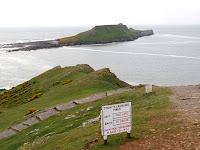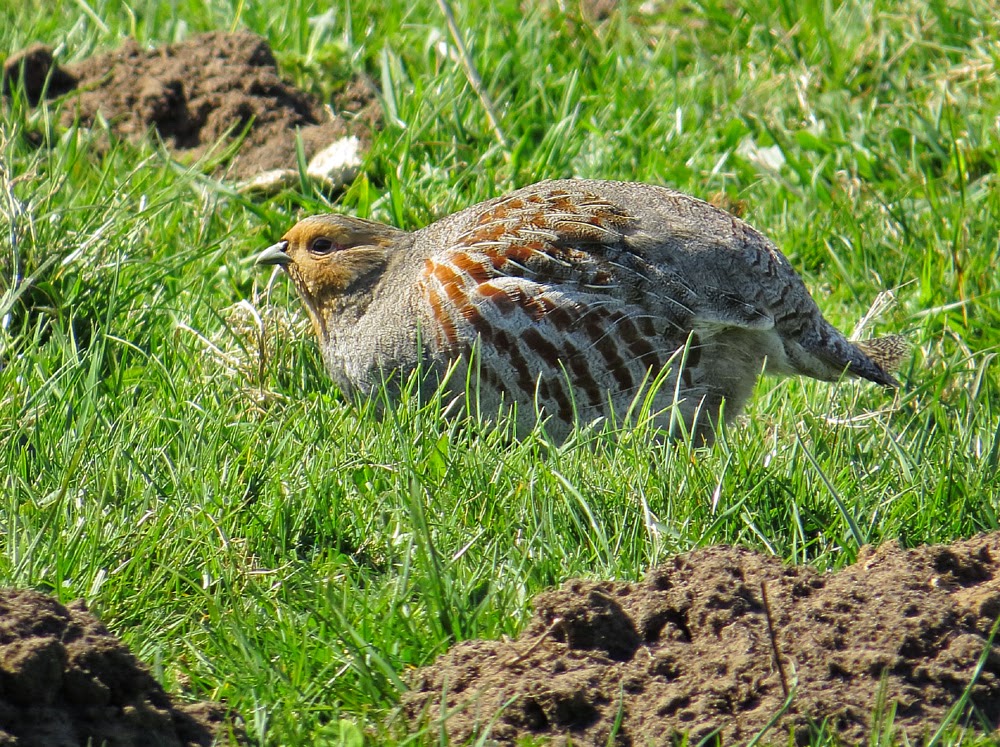Otmoor is a nature reserve of wet meadows and reedbeds only a few miles from Oxford city centre. But if you've never been there it can be a little tricky to locate. The car park is off Otmoor Lane in the village of Beckley, but we didn't see a single signpost saying RSPB Otmoor until we reached the car park! If you drive east along the High Street in Beckley, with the Abingdon Arms pub on your left, at the end of the High Street (you continue straight ahead rather than following the road around to the right). It looks like a dead end but Otmoor lane is a left turn obscured by the last house on the left. If we hadn't asked someone we would have assumed this was a dead end and driven somewhere else.
We stopped for lunch first at The White Horse Inn, a tasty Thai meal, and while sitting out on the patio in the sun, a couple of Red kites drifted overhead - several times, I think they were looking at our lunch!
 |
| Red kite overhead at the White Horse, Forest Hill. |
Although South Wales is undoubtedly the best place to visit to see and photograph Red kite, the area around Oxford especially along the M40 corridor and from Wendover and Princes Risborough in Buckinghamshire south past High Wycombe and into South Oxfordshire there are numerous pairs and it isn't uncommon to see 5 or 6 together - often more.
As I parked the car in the RSPB car park I noticed a juvenile Brown hare which was paying little attention to its surroundings, I was able to approach fairly close to get some shots but the light was against me for a lot of them so only limited success.
I was soon distracted from the Hare by the sound of a Turtle dove calling. I saw it on an overhead wire alongside the path. Luckily for much of my route to it I was screened by a hedge, so I was able to get quite close before having to step out for a photo. It seemed fairly unconcerned by my presence and after a few seconds observing me continued its calling. Unfortunately there was a large ceramic insulator next to the dove and it rather spoilt the view but I took lots of shots before attempting to get into a better position - I was able to walk right past the bird to take some shots without the insulator but these don't show the beautiful patterning on the wings.
Click photo to enlarge.
Ideally it would have been nice to see one in a tree rather than the stark power lines, luckily for me that is exactly what happened on my return visit. This time wasn't supposed to be a visit to a bird reserve, it was just coincidental that we happened to be in the area and I happened to know Otmoor reserve was nearby!
My last 'bird on a wire' for the day was a male Reed bunting which was singing away happily but completely silhouetted with the sun behind him, again, I was able to walk past (and directly beneath) it without it flying off so I could get a better shot with the sun on it.
With a couple of hours to kill before collecting our daughter and all her possessions from university, I used my powers of persuasion to convince my wife we should return to Otmoor. No sign of the Hare today but the Turtle dove could still be heard calling. I saw a large group of birders using binoculars and scopes to watch it but it was too distant for a photo. However, on following the path to the hide I realised we would be walking right past the dove in the tree if it didn't fly off in the mean time. It didn't, I managed to finally get a decent photo of a Turtle dove in natural surroundings.
We didn't see much of note on the rest of the journey to the hide but once there we watched a group of 5 distant Red kites swooping around, a Sparrowhawk gave a fly by and two Brown hares sat grooming themselves in the field for a good 20 minutes. On the return along the path to the car park I spotted a pair of Common terns, they sat side by side for a while and then mated.
We were about to walk on when my wife spotted a small wader at the waters edge, I borrowed the binos' and couldn't believe my luck, it was a Little ringed plover, a life tick for me - it wasn't a particularly good view but you could see the dark bill, yellow eye ring and pale legs. I am surprised I've not seen them before, they get a 'Green' status according to the RSPB website whereas the Ringed plover is an 'Amber' status and I see dozens of these every time I visit the beaches in winter and occasionally during the summer as well.
It is only a record shot but nice to see one all the same.
A few birds were using the feeders set up near the path, a Great spotted woodpecker, plenty of Goldfinches and Great tits and a few Greenfinches. The feeders were a little bit too far away for a great shot but I sat quietly by the fence and managed a half decent Greenfinch.
We didn't have long at the reserve but it is certainly worth a visit if you are anywhere near Oxford.





















































